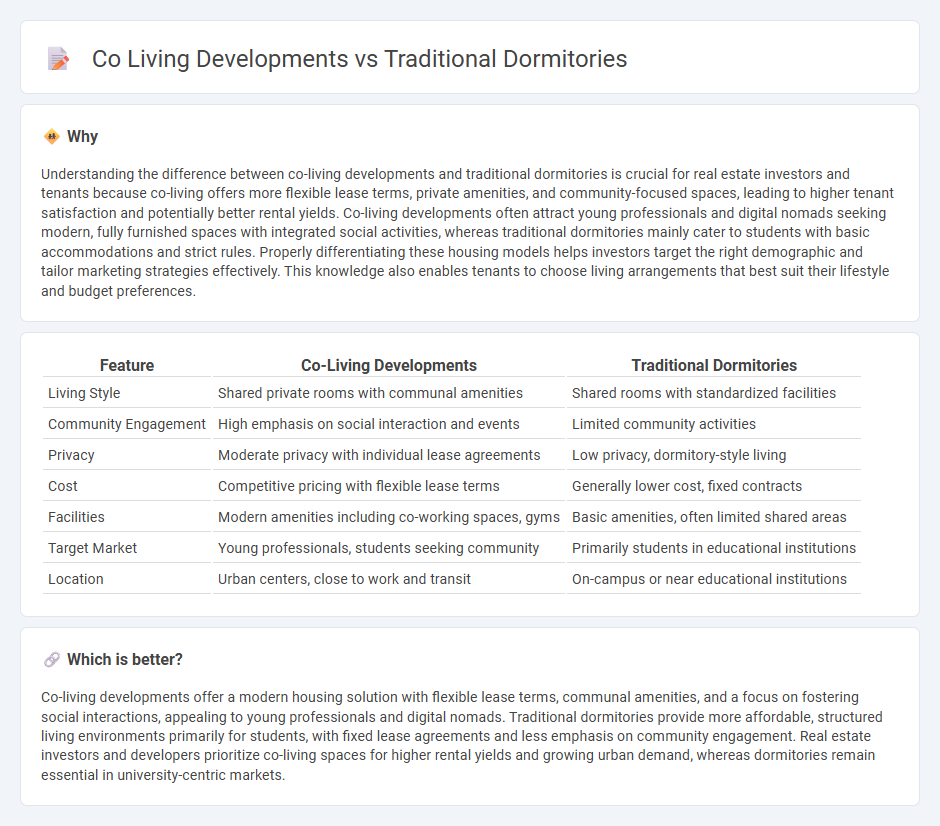
Co-living developments offer flexible lease terms, modern amenities, and community-focused layouts that foster social interaction, contrasting with traditional dormitories characterized by rigid contracts and basic accommodations. These innovative residential models emphasize shared spaces and collaborative living experiences appealing to young professionals and students seeking affordability and networking opportunities. Explore the benefits and design trends shaping co-living developments versus traditional dormitory options.
Why it is important
Understanding the difference between co-living developments and traditional dormitories is crucial for real estate investors and tenants because co-living offers more flexible lease terms, private amenities, and community-focused spaces, leading to higher tenant satisfaction and potentially better rental yields. Co-living developments often attract young professionals and digital nomads seeking modern, fully furnished spaces with integrated social activities, whereas traditional dormitories mainly cater to students with basic accommodations and strict rules. Properly differentiating these housing models helps investors target the right demographic and tailor marketing strategies effectively. This knowledge also enables tenants to choose living arrangements that best suit their lifestyle and budget preferences.
Comparison Table
| Feature | Co-Living Developments | Traditional Dormitories |
|---|---|---|
| Living Style | Shared private rooms with communal amenities | Shared rooms with standardized facilities |
| Community Engagement | High emphasis on social interaction and events | Limited community activities |
| Privacy | Moderate privacy with individual lease agreements | Low privacy, dormitory-style living |
| Cost | Competitive pricing with flexible lease terms | Generally lower cost, fixed contracts |
| Facilities | Modern amenities including co-working spaces, gyms | Basic amenities, often limited shared areas |
| Target Market | Young professionals, students seeking community | Primarily students in educational institutions |
| Location | Urban centers, close to work and transit | On-campus or near educational institutions |
Which is better?
Co-living developments offer a modern housing solution with flexible lease terms, communal amenities, and a focus on fostering social interactions, appealing to young professionals and digital nomads. Traditional dormitories provide more affordable, structured living environments primarily for students, with fixed lease agreements and less emphasis on community engagement. Real estate investors and developers prioritize co-living spaces for higher rental yields and growing urban demand, whereas dormitories remain essential in university-centric markets.
Connection
Co-living developments and traditional dormitories both provide shared residential spaces designed to foster community among occupants, focusing on affordability and social interaction. Co-living spaces often incorporate modern amenities and flexible lease terms, appealing to young professionals, while traditional dormitories primarily serve students with structured, institution-managed environments. Both models optimize urban real estate by maximizing occupancy and communal living benefits, addressing the demand for affordable housing in metropolitan areas.
Key Terms
Communal Spaces
Traditional dormitories typically feature standardized communal spaces such as shared bathrooms, study rooms, and basic common areas designed for functionality and cost efficiency. Co-living developments prioritize versatile communal spaces that foster social interaction, creativity, and wellness, including lounges, kitchens, co-working areas, and fitness centers. Explore the benefits of each living arrangement's communal design to determine the best fit for your lifestyle and community needs.
Lease Flexibility
Co-living developments offer greater lease flexibility compared to traditional dormitories, often providing month-to-month or short-term rental options tailored to tenants' dynamic lifestyles. Traditional dormitories typically require fixed, long-term leases aligned with academic semesters, limiting flexibility for students or residents needing early termination or extension. Explore in-depth comparisons to understand how flexible leasing can enhance your residential experience.
Privacy Levels
Traditional dormitories often feature shared rooms and common bathrooms, offering limited privacy for residents. Co-living developments typically provide private bedrooms with individual bathrooms, enhancing personal space while fostering community interaction. Explore more about how privacy levels impact student living experiences and lifestyle choices.
Source and External Links
Dormitory - A building primarily providing sleeping and residential quarters for large numbers of people such as students.
Traditional Style Housing - Offers traditional-style residence halls with co-ed rooms, community bathrooms, and shared lounges.
Traditional Rooms - Provides classic college living with shared spaces and community-focused environments in halls like Calhoun and Siddall.
 dowidth.com
dowidth.com